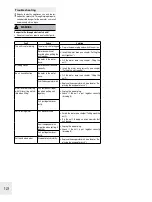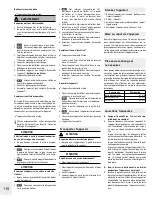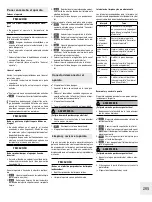
11
CAuTION
Damage to the unit due to removal of the float
body (styrofoam)!
▶
Do not remove the float body (styrofoam) when
unpacking the unit.
3.
Push the new evaporator wick onto the
float basket.
4.
To close the float assembly, place the
float tip on the float basket and the evapo-
rator wick, push down and turn clockwise
(CLOSE arrow).
5. To check, gently pull the float tip upwards. In do-
ing so, it should not lift off the float basket.
6. If necessary, turn the float tip again and re-
check.
7. Insert the float assembly into the empty water
base.
8. Put the unit together (see chapter "Putting the
unit together").
Replacing the Ionic Silver Stick
®
✔
Unit is taken apart and emptied from water.
1. Remove the Ionic Silver Stick
®
from the bottom
of the water base and discard it.
2. Place the new Ionic Silver Stick
®
in the holder at
the bottom of the water base.
3. Insert the float assembly into the empty water
base.
4. Put the unit together (see chapter "Putting the
unit together").
Putting the unit together
✔
Unit is taken apart and emptied from water.
1. Insert the float assembly into the water base.
2.
Place the water base including the float
assembly on the base handles into the base.
3. Place the upper part onto the base.
4.
Ensure that the unit is put together cor-
rectly.
5. Ensure that there are no foreign objects in the
unit.
➥
The unit is put together.
Transporting the unit
CAuTION
Risk of injury by falling parts!
▶
Always handle the unit by the base when un-
packing and lifting.
CAuTION
Water damage due to water spilling over!
▶
Empty the unit before transporting.
1. Empty the unit (see chapter "Taking apart and
emptying the unit").
2. Dry the unit.
3. Pick the unit up by the base and carry it to the
desired location.
H 3
H 4
B 5
B
Storing the unit
1. Clean the unit (see chapter "Cleaning and servic-
ing the unit").
2. Dry the unit.
3. Pack the unit, preferably in the original packag-
ing.
4. Store the unit in a dry, cool place.
Disposing of the unit
Pass the outdated unit onto a specialized retailer
for professional disposal. Observe the applicable
national specifications when disposing of the unit.
You can find out about further disposal possibilities
from your municipality.
Spare parts and accessories
You can purchase spare parts and accessories from
specialized retailers and replace them on the unit
yourself. Only original parts from the manufacturer
can be used. Repairs can only be carried out by pro-
fessionals. This also applies to a faulty power cord.
Accessories
Designation
Evaporator wick
A7018
Ionic Silver Stick
®
A7017
Decalcification agent
A7417
Frequently asked questions
Q. Why is the air moisture too low in my room?
A. How often do you use the unit? If the unit is only
in operation at night, the air moisture decreases
during the day as moisture is not being added to
the air constantly.
Wood, leather, carpeting, curtains and other
materials absorb a lot of moisture, resulting in
a decrease in air moisture.
If the window is open, moisture can escape
from the room.
A common reason is that the unit is placed next
to a heater in order to disperse the moisture
quickly throughout the room with the hot air.
However, this does not work. The escaping hot
air absorbs the majority of the moisture before
reaching the room air at all.
Q. Should I leave my door open or closed while
the unit is in operation?
A. With an open door, the moisture escapes the
room and disperses itself in other areas of the
house. If you want to increase the air moisture
in a certain room, you should make sure that
the door to that room remains closed while the
unit is in operation.
Q. How high should the air moisture be in my
room?
A. Air moisture of 40–60 % is recommended.
Q. What are the consequences of too low or too
high air moisture?
A. Dry air can lead to dry skin, electrostatic charg-
es, out of tune musical instruments, increased
dust development, damage to wooden items
(drying out and cracking), illness, disease and
drying out the nasal mucous membranes. Too
high air moisture can result in mold develop-
ment and wall paper falling off.
Q. Why do I need an Evaporator if I could also
simply open the window?
A. The air moisture in the outside air is not high
enough to moisturize a room.
Q. Where should I place my Evaporator?
A. The unit should be placed in the middle of the
room and not at a wall, a window, a door or
a thermal bridge so that the air can circulate
freely around the unit.
Q. Can I clean the water base in the dishwash-
er?
A. No, you cannot clean the water base in the
dishwasher as it would otherwise melt.
General information about air
humidification
Did you know that air that is too dry
• dries out mucous membranes and additionally
causes chapped lips and stinging eyes?
• promotes infections and sicknesses of the respi-
ratory passages?
• leads to a lack of energy, exhaustion and concen-
tration weakness?
• burdens pets and room plants?
• encourages dust development and the electro-
static charge of synthetic textiles, carpets and
synthetic flooring?
• damages wooden fixtures, especially hardwood
floors?
• puts musical instruments out of tune?
The physical comfort of man and animal is depen-
dent on many influences. One of those is correctly
humidified air. During the heating period, the cold
outside area which streams into living spaces
through the windows is warmed. This results in a
plummet in the relative air moisture. An adverse
climate for plants and animals, wooden objects and
furniture dry out and people feel uncomfortable and
are susceptible to colds in higher numbers. As a
rule, room climate is comfortable when the relative
moisture is between 40 % and 60 %. Air humidifica-
tion is especially useful in the winter.
Содержание E2441A
Страница 3: ...A 2 A 3 A 4 A 7 A 10 A 5 A 8 A 11 A 12 A 9 A 6 A 1 A A 13 30cm 120cm A 14 ...
Страница 5: ...C C 1 C 2 C 3 C 4 C 5 C 6 C 7 ...
Страница 6: ...S T O P D E S T O P D 1 D 2 D 3 E 1 E 2 E 3 E 4 ...
Страница 7: ...F H F 2 F 3 F 5 F 4 F 6 G H 3 F 1 H 4 H 2 H 1 G 3 G 2 G 1 ...
Страница 114: ...108 ...



































